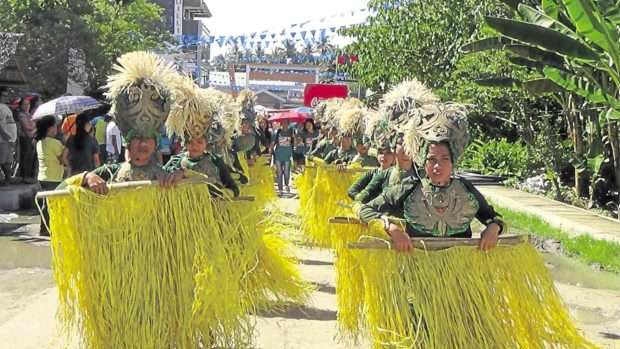After Sayyaf, fake news terrorizes town

Though their town still reels from the April 10 attack by Abu Sayyaf, Inabanga villagers take part in a street dancing competition for the town’s Raffia Festival. —LEO UDTOHAN
INABANGA, Bohol— Nearly three months after gunmen belonging to a homegrown terror group tried to set up base in this Bohol town, fear continues to haunt residents in another form — fake news.
But nothing could stop the town from moving on — and days before it celebrates its fiesta, fighting fake news could prove to be as formidable a task as keeping terrorists off.
Days before they celebrate their town’s feast, villagers were gripped with fear over fake news, circulating in social media, that the town would be bombed.
It was not funny as the town was still reeling from an attack on April 10 by gunmen belonging to the crime gang Abu Sayyaf, an organization with ties to the terror network al-Qaeda but had joined the Islamic-State inspired Maute Group.
Rumors circulated over a wreath left at the public cemetery and addressed to the municipal government. It read: “Happy fiesta.”
Article continues after this advertisementMunicipal officials, however, refused to cower in fear.
Article continues after this advertisement“Let’s not believe fake news,” said Inabanga Mayor Josephine Socorro Jumamoy. “Let’s try to live a normal life,” she added.
Terror nightmare
She urged people to go out and become instruments of peace in a town that was still haunted by the nightmare of the April 10 attack, when at least 10 members of Abu Sayyaf, with the help of an Inabanga native, entered the town and tried to set up a base there.
After authorities got wind of the terrorists’ presence in Inabanga, operations were launched to finish them off which lasted for more than a month.
But fear still haunts residents, who worry about the return of the terrorists to retaliate against civilians who helped authorities mostly by giving tips on the terrorists’ location.
In a gesture meant to show that the threat was gone, the municipal government held a street dancing competition during the town fiesta on June 30.
Ten contingents from 50 villages joined the Raffia Festival street dancing competition in the afternoon.
Raffia, a natural fiber obtained from buri palm, is one of Bohol’s leading products, mainly used as material for handcrafted wares.
The festival sought to enliven the raffia loom-weaving industry which had been reeling from the effects of the 7.2-magnitude earthquake that hit Bohol in October 2013, and the Abu Sayyaf crisis in April.
The festival was a success, Jumamoy said.
World-renowned product
She said more than 1,000 individuals were engaged in home-based raffia loom-weaving in the town. At least 525 plant-based weavers still make raffia.
Before the earthquake in 2013, Jumamoy said Inabanga’s raffia-based crafts had gained fame and recognition worldwide.
She said a room at the White House was decorated with raffia. She also said Hollywood actress Angelina Jolie was seen carrying a bag made of raffia designed from Inabanga.
“Raffia in Inabanga is 100-percent handwoven. That’s the beauty [of it]; it’s natural,” she said.
Jumamoy, however, expressed lament that some people preferred to use plastic since making raffia took longer.
Raffia fiber is stripped from dried young buri palm leaves—some are dyed while others are kept in their natural colors—before these are woven by hand or modern looms.
According to Jumamoy, loom weaving has been the most important cottage industry in Inabanga since Hispanic times.
She said that during the Dagohoy uprising, woven cloths were made into uniforms for resistance fighters.
She was referring to the revolt staged by Boholano rebel Francisco Dagohoy, who led the longest revolt against Spain.
It took the Spaniards 85 years to quell the uprising that was triggered by a Jesuit priest’s refusal to grant a Christian burial to Dagohoy’s brother.
Through the years, the town’s weaving industry has evolved, producing crafts sold locally and abroad.